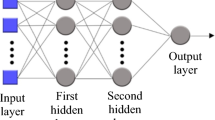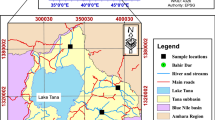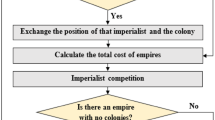Abstract
In this paper, the calculation and estimation of the loess of samples taken from the North of Iran (Golestan Province) have been investigated. The soil used in this study has been called loess which is defined as a loose, open-structured, and metastable soil which can withstand high overburden stresses being dry, while upon saturation, the soil collapses creating enormous engineering problems. The engineering properties of the collapsible soils have been determined, which include the specific gravity, Atterberg limits, grain size distribution, and dry density. The hydrocollapsibility properties, due to wetting under different stress levels, have been measured in single-oedometer tests. Then, three neural networks have been proposed to estimate the collapse potential of soils on the basis of basic index properties. Field data, consisting of index properties and collapse potential, have been used to train and test different neural networks. Various neural network architectures and training algorithms have been examined, and a comparison study has been carried out to prove the efficiency of three types of neural networks including the multilayer perceptron (MLP) network, radial basis function (RBF) network, and adaptive neuro-fuzzy inference system (ANFIS). The effect of related parameters suppression from simulations has been analyzed. The numbers of train data and test data have been changed, and also, in-depth analysis of samples has been carried out to evaluate the efficiency of different networks. Finally, the optimal performance of estimation achieved by the best network has been presented.



Similar content being viewed by others
References
Ahmad Fadzil MH, Evans DJ, Zainuddin Z (2001) Optimization of learning methods for face recognition using multilayer perceptron. Proceedings of the 3rd IASTED International Conference on Signal and Image Processing, Honolulu, Hawaii, USA, Aug 13–16
Andalibi M (1994) Geological map 1/250000. Geol Surv Iran
Barden L, Mc Gown A, Collins K (1973) The collapse mechanism in partly saturated soil. Eng Geol 7:49–60
Broomhead DS, Lowe D (1988) Multivariable function interpolation and adaptive networks. Complex Syst 2:321–335
Cichoki A, Unbehauen R (1993) Neural networks for optimization and signal processing. John Wiley & Sons, Stuttgart
Cybenko G (1989) Approximation by super position of a sigmoidal function. Math Control Signals Syst 2:303–314
Day RW (2000) Soil testing manual. Mc-Graw Hill, NY
Derbyshire E, Kemp AR, Meng X (1997) Climate change, loess and paleosols: proxy measures and resolution in North China. J Geol Soc 154:793–805
Donahue RL, Miller RW, Shickluna JC (1977) Soils: an introduction to soils and plant growth, 4th edn. Prentice Hall, Englewood Cliffs
Doulati Ardejani F, Rooki R, Jodeiri Shokri B, Aryafar A (2013) Prediction of rare earth elements in neutral alkaline mine drainage from Razi coal mine, Golestan, northeast Iran, using general regression neural network. J Environ Eng ASCE 139(6):896–907
Feiznia S, Ghauomian J, Khajeh M (2005) The study of the effect of physical, chemical and climate factors on surface erosion sediment yield of loess soils (case study in Golestan Province. Pajouhesh and Sazandegi 66:14–24
Fookes PG (1997) (ed.) Tropical residual soils, a geological society engineering group working party revised report. The geological society, London
Gerard A, Kruse M, Dijkstra AT, Schokking F (2007) Effects of soil structure on soil behavior: illustrated with loess, glacially loaded clay and simulated flaser bedding examples. Eng Geol 91:34–45
Hayati M, Shirvany Y (2007) Artificial neural network approach for short term load forecasting for Illam Region. WASET: Int Sci Index 1(4)
Haykin S (1999) Neural networks: a comprehensive foundation, 2nd edn. Prentice Hall, Upper Saddle Rever
Heller F, Evans ME (1995) Loess magnetism. Rev Geophys 33:211–240
Hornik K, Stinchcombe M, White H (1989) Multilayer feed forward networks are universal approximator. Neural Netw 2(5):359–3661
Houston SL (1995) Foundations and pavements on unsaturated soils—part 1: collapsible soils, 3rd edn, Proceedings of the 1st international conference unsaturated soils. Balkema, Paris, pp 1421–1439
Jang JS (1993) ANFIS: adaptive-network-based fuzzy inference systems. IEEE Trans Syst Man Cybern Part B Cybern 23:665–685
Jennings JE, Knight K (1975) A guide to construction on or with materials exhibiting additional settlement due to collapse of grain structure. Proceedings of the 6th African conference on soil mechanics and foundation engineering 99–105
Jinfeng L, Zhengtang G, Yansong Q, Qingzheng H, Baoyin Y (2006) Eolian origin of the Miocene loess-soil sequence at Qin’an, China: evidence of quartz morphology and quartz grain-size. Chin Sci Bull 50:2806–2809
Jodeiri Shokri B, Ramazi HR, Doulati Ardejani F, Sadeghiamirshahidi M (2013) Prediction of pyrite oxidation in a coal washing waste pile applying artificial neural networks (ANNs) and adaptive neuro-fuzzy inference systems (ANFIS). Mine Water Environ. doi:10.1007/s10230-013-0247-3
Kisi O, Uncuoglu E (2005) Comparison of three back-propagation training algorithms for two case studies. Indian J Eng Mater Sci 12:434–442
Mansour Z, Chik Z, Taha MR (2008) On soil collapse potential evaluation. ICCBT 3:21–32
Mitchell JK (1993) Fundamental soil behavior. Wiley, NY
Moody J, Darken C (1989) Learning with localized receptive fields. In: Touretzky D, Hinton G, Sejnowski T (eds) Proceedings of the 1988 connectionist models summer school. Morgan Kaufmann, San Mateo
Rezaei H (2008) Geological zoning map of Golestan Province soils. Golestan Regional Water Company
Reznik YM (2007) Influence of physical properties on deformation characteristics of collapsible soils. Eng Geol 92:27–37
Rogers CDF (1994) Hydrocconsolidation and subsidence of loess: studies from China, Russia, North Americas and Europe. Eng Geol 37:83–113
Rogers CDF (1995) Types and distribution of collapsible soils. Proceedings of the NATO advanced research workshop on genesis and properties of collapsible soils. Loughborough, U.K. 1–17
Salehi T (2011) Engineering geology investigation of loess soils in Golestan. Master thesis, Bu Ali Sina University
Sariosseiri F, Muhunthan B (2009) Effect of cement treatment on geotechnical properties of some Washington soils. Eng Geol 104(1-2): 119–125
Wasserman PD (1989) Neural computing—theory and practice. Van Nostrand Reinhold, New York
Zainuddin Z, Evans DJ (2003) Human face recognition using accelerated multilayer perceptrons. Int J Comput Math 80(5):535–558
Acknowledgments
We would like to express our appreciation to Dr. Soheil Ganjefar for his valuable suggestions during the planning and development of this research work.
Author information
Authors and Affiliations
Corresponding author
Appendixes
Appendixes
Appendix 1
Effective parameters of the study:
-
Input:
-
Particle size (grain percentage)
-
Gravel percentage (gravel %)
-
Sand percentage (sand %)
-
Silt percentage (silt %)
-
Clay percentage (clay %)
-
-
Physical-mechanical properties
-
Natural moisture content (w)
-
Void ratio (e)
-
Dry density (g/cm3) (γ d)
-
Degree of saturation (S)
-
Liquid limit (l l)
-
Activity (A)
-
Inverse of the liquidity index (1/l i)
-
-
Chemical properties
-
Calcium carbonate (CaCO 3)
-
-
Other properties
-
Type of sediment
-
Climate
-
Age
-
Precipitation
-
Vegetation
-
-
-
Outputs:
-
Collapse potential
-
Ic%
-
-
Appendix 2
Rights and permissions
About this article
Cite this article
Salehi, T., Shokrian, M., Modirrousta, A. et al. Estimation of the collapse potential of loess soils in Golestan Province using neural networks and neuro-fuzzy systems. Arab J Geosci 8, 9557–9567 (2015). https://doi.org/10.1007/s12517-015-1894-4
Received:
Accepted:
Published:
Issue Date:
DOI: https://doi.org/10.1007/s12517-015-1894-4




